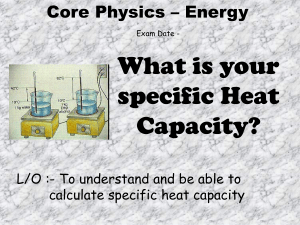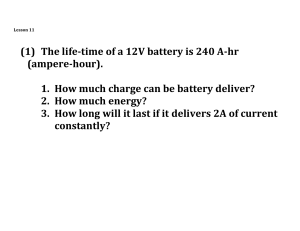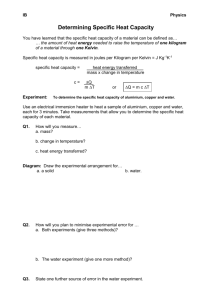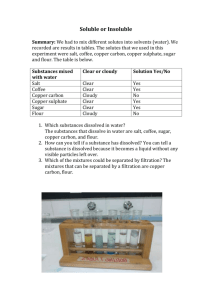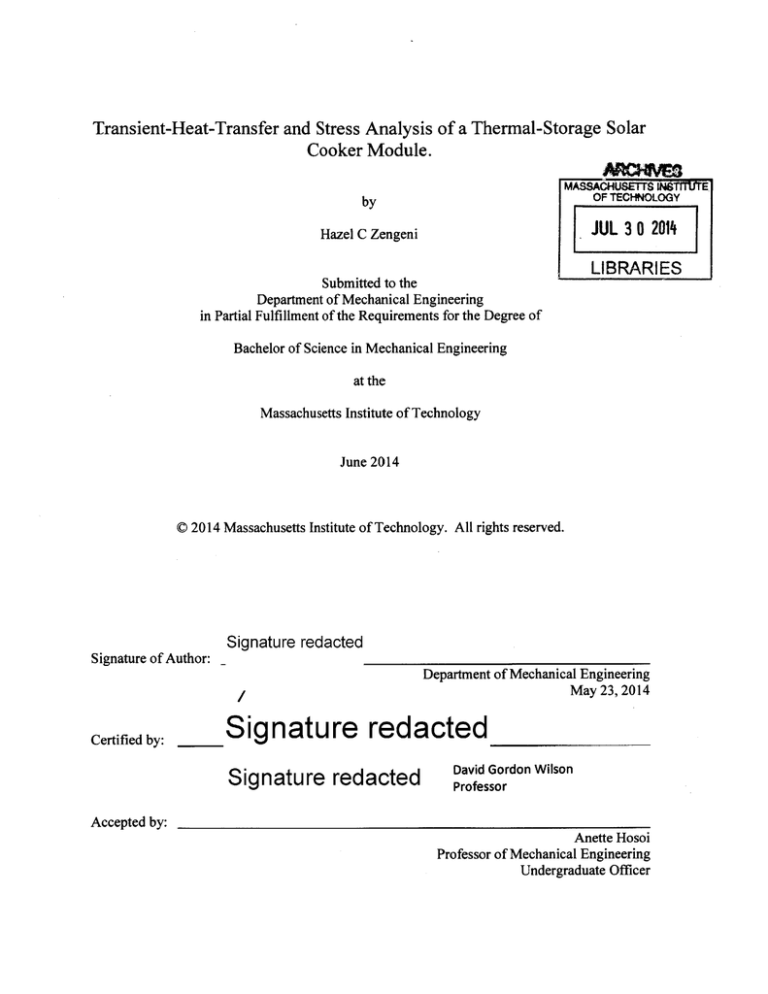
Transient-Heat-Transfer and Stress Analysis of a Thermal-Storage Solar
Cooker Module.
by
MASSACHUSEMTS IRUTmfrE
OF TECHNOLOGY
Hazel C Zengeni
JLBRRE2014
Submitted to the
Department of Mechanical Engineering
in Partial Fulfillment of the Requirements for the Degree of
LIBRARI ES
Bachelor of Science in Mechanical Engineering
at the
Massachusetts Institute of Technology
June 2014
C 2014 Massachusetts Institute of Technology. All rights reserved.
Signature redacted
Signature of Author:
/
Department of Mechanical Engineering
May 23, 2014
Certified by:
Signature redacted
Signature redacted
David Gordon Wilson
Professor
Accepted by:
Anette Hosoi
Professor of Mechanical Engineering
Undergraduate Officer
Transient-Heat-Transfer and Stress Analysis of a Thermal-Storage Solar
Cooker Module.
by
Hazel C Zengeni
Submitted to the Department of Mechanical Engineering
on May 23, 2014 in Partial Fulfillment of the
Requirements for the Degree of
Bachelor of Science in Mechanical Engineering
ABSTRACT
This paper details the analysis carried out in Solidworks to determine the best material and
configuration of a thermal-storage solar cooker module.The thermal-storage solar cooker utilizes
the high-latent-heat lithium nitrate releases when transitioning from liquid to solid
state.However,before this process can transpire the salt has to be completely melted and the
energy needed for the melting process is provided by the sun.The purpose of the module is to
conduct the solar power from the heat source to the salt.In addition after the melting process,it
conducts the latent energy released by the salt to the hot plate used for cooking.
Thesis Supervisor: Professor David Gordon Wilson
Title: Professor Emeritus
Contents
1
Introduction
1.1
2
3
Background . . . . . . . . . . . . . . . . . . . . . . . . . . . .
Method
2.1 Modeling the salt and module in Solidworks
2.2 3-D Assembly of the module and salt . . . .
2.3 Transient-heat-transfer analysis in Solidworks
2.4 Results from transient-heat-transfer analysis
2.5 Conclusions: Transient-heat-transfer analysis
2.6 Thermal stress analysis . . . . . . . . . . . .
2.7 Conclusions: Thermal stress analysis . . . .
. . .
. . .
. .
. . .
. . .
. . .
. . .
.
.
.
.
.
.
.
.
.
.
.
.
.
.
.
.
.
.
.
.
.
.
.
.
.
.
.
.
.
.
.
.
.
.
.
.
.
.
.
.
.
.
3
5
.
5
.
8
.
9
. 11
. 17
. 18
. 21
3
Recommendations and future work
22
4
Bibliography
22
List of Figures
1
2
3
4
5
6
7
8
9
10
11
12
13
14
Dave Wilson's drawing of the thermal-storage solar cooker. . .
The top of the hot plate where the circular target where the
heat will be concentrated on then distributed throughout the
module.Units are in mm . . . . . . . . . . . . . . . . . . . . .
The bottom of the hot plate where fins potrude from the surface.Units are in mm . . . . . . . . . . . . . . . . . . . . . . . .
Lithium nitrate.The extruded cuts are the spaces to be filled
out by the fins when the salt is paired up with the module.Units are in mm . . . . . . . . . . . . . . . . . . . . . . . .
3-D CAD of the module with a conical target. . . . . . . . . .
Module and salt assembly.Units are in mm. . . . . . . . . . . .
Temperature sensor locations on the salt. . . . . . . . . . . . .
25 copper rods configuration with a power input of 1000W. .
25 copper rods configuration with a power input of 500W. .
25 copper rods configuration with a power input of 500W and
20mm target area diameter. . . . . . . . . . . . . . . . . . . .
25 copper rods configuration with a power input of 500W and
a conical target. . . . . . . . . . . . . . . . . . . . . . . . . . .
24 copper rods configuration with a power input of 1000W. .
24 copper rods configuration with a power input of 500W. .
25 aluminium rods configuration with a power input of 1000W.
1
4
5
6
7
8
9
10
11
12
12
13
13
14
14
15
16
17
18
19
20
21
22
23
25 aluminium rods configuration with a power input of 500W.
25 aluminium rods configuration with a power input of 500W.
24 aluminium rods configuration with a power input of 1000W.
25 cast iron rods configuration with a power input of 500W
and 20mm target area diameter. . . . . . . . . . . . . . . . . .
Nonlinear study of the 25 copper rods configuration with a
power input of 500W.Diameter of target is 10mm. . . . . . . .
Nonlinear study of the 25 copper rods configuration with a
power input of 500W.Diameter of target is 20mm. . . . . . . .
Nonlinear study of the 25 Copper rods configuration with a
power input of 500W.Diameter of target is 30mm. . . . . . . .
Figure of the 25 copper rods configuration with a power input
of 500W.The target area was a conical depression. . . . . . . .
Static study of the 25 copper rods configuration with a power
input of 500W.Diameter of target is 20mm . . . . . . . . . . .
15
15
16
16
18
19
19
20
21
List of Tables
1
Table showing material properties.
2
. . . . . . . . . . . . . . . 10
1
1.1
Introduction
Background
Professor Dave Wilson initially came up with a design for the thermal-storage
solar cooker module that comprises of a hot plate attached to fins.This module is used to conduct heat into the lithium nitrate salt.However there are
a couple of constraints that include the melting point and decomposition
temperature of lithium nitrate.As it is very time consuming and almost impossible to test out every possible design and material type,the need for an
analytical reduction method arose.Fig 1 shows the initial design prototyped
by Dave Wilson.
Firstly the thermal modeling would aid the designers in choosing the
best material for making the module.There were three different materials
for consideration;copper,aluminium and cast iron each having its own advantages and disadvantages.However the thermal performance of the metals is very critical and can outweigh other factors like cost per unit volumeweight,longevity and reaction to external conditions.
Secondly the geometry of the hot plate and the arrangement of fins has an
effect on the uniformity of the melting process and the total time it takes for
the salt to melt.Because of this the modeling became critical in determining
the geometry of the module which in turn affects the size and weight of the
solar cooker.
Thirdly after coming up with the optimum design,the study also had to
show how long the entire melting process would take and ensure the temperature of the salt at any point would still be below the decomposition
temperature.
Lastly there were concerns of thermal stresses that arise result due to the
high temperature gradients introduced by the heat source so the software
had to be able to provide the thermal effects.
According to [2],taking all these requirements into consideration,the software most capable of achieving all of them was discovered to be Solidworks.Solidworks is a solid modeling CAD(computer-aided-design) which
also offers a Finite Element Analysis (FEA) design validation tool that can
handle some multiphysics simulations as well as nonlinear studies.The validation tool can handle transient thermal analysis and also derives static
3
analyses from thermal effects.
INSULATED DOME
OT1E5 INULATION
HIGWTEMPERATUItE SEALANT
SOUD LEVEL
AIRGAP
UQWD LEVEL
PEENCO-OVER UIP TO LMC
PATE To T14ERMAL $TORE
HM K
*
FOAMED-GLASS iNSL#ATION
SOLAR-COKER APPROXIMATE DIMENSIONS AND ARRANGEMENT
00Mvdfow Wson Z014 04 0
Figure 1: Dave Wilson's drawing of the thermal-storage solar cooker.
4
2
2.1
Method
Modeling the salt and module in Solidworks
Firstly the models were based on the dimensions of the solar cooker Dave
Wilson had prototyped.
Figure 2 shows the top of the hot plate with the circular heat target as
well as the right,bottom and isometric views of the part.The side view shows
the length of the fins as well as the diameter and thickness of the hot plate.
Figure 3 shows the bottom surface of the hot plate where the fins protrude
from the surface.
Figure 4 shows the model of the salt with the depressions representing
the spaces the fins will fill out once an assembly of the parts is made.
]
-+-
IIIIH I
( 4
L-
0
Figure 2: The top of the hot plate where the circular target where the heat
will be concentrated on then distributed throughout the module.Units are in
mm
5
.4
.4,
U
II
Figure 3: The bottom of the hot plate where fins potrude from the surface.Units are in mm.
6
0
0
ao~
*0 0 S
a A *d
0000
0
C
-
Figure 4: Lithium nitrate.The extruded cuts are the spaces to be filled out
by the fins when the salt is paired up with the module.Units are in mm
The dimensions of the hot plate and target area were however altered
after initial trial runs to come with the optimum design best suited for the
users of the solar cooker and other design considerations.
One the changes included changing the geometry of the target area to a
conical depression of diameter 20mm and a height of 20mm.
7
-
00
Figure 5: 3-D CAD of the module with a conical target.
2.2
3-D Assembly of the module and salt
The assembly between the salt and module was supposed to achieve the
following conditions:
e A 10mm air gap between the salt and the bottom of the hot plate.This
air gap allows for expansion of the salt as it is being heated up.
e A 10mm gap between the bottom of the fins and the bottom of the
salt.
Fig 6 shows the engineering drawings for the assembly.The right and
bottom views show the 10mm gap requirement.
8
.7
a
a
[~~7
Figure 6: Module and salt assembly.Units are in mm.
2.3
Transient-heat-transfer analysis in Solidworks
The following steps were taken to carry out the transient-heat-transfer analysis in solidworks:
" Open a thermal analysis in Solidworks and under properties select transient study specifying total time and the time step.
" Define initial conditions of the study which was an initial temperature
of 25 C.
* Define the heat power input and select the target area for the power.
" Define material properties for the module and the salt.
* Add temperature sensors on the top of the salt-fin interface at each
radius away from the center of the hot plate.
9
Figure 7: Temperature sensor locations on the salt.
The table below shows the material properties for the four materials used
in the thermal studies.The materials are copper,aluminium,cast iron and
lithium nitrate.The properties for lithium nitrate were extrapolated from
the properties of LiN0 3-NaNO3 [1].
Materials
Thermal Conductivity[W/m.K]
Aluminium
170
Cast Iron
45
Solid lithium nitrate
0.53
Specific Heat [J/(kg.K)]
390
1300
510
1500
Density[kg/m]
Melting Point[OC]
Decomposition Temperature [ 0 C]
Yield Strength [MPa]
8900
1085
258
2700
660
7200
1200
-
-
14000
255
600
55
98
Table 1: Table showing material properties.
10
-
Copper
390
2.4
Results from transient-heat-transfer analysis
The transient analysis was carried out under different heat intensity conditions and different module materials to produce the following plots.
.
1. This analysis was run using copper as the module material.The power
input was 1000W and the diameter of the target was 10mm.As a result
2
the power intensity was found to 3.19MW/m
500
-*+Center
30mm
60mm
200
-95rm
E 1009
1-
0
----0
2000
4000
8000
6000
12000
10000
Time(Seconds)
Figure 8: 25 copper rods configuration with a power input of 1000W.
.
2. This analysis was run using copper as the module material.The power
input was 500W and the diameter of the target was 10mm.As a result
2
the power intensity was found to 0.8MW/m
11
600
A
500
400
Center
-300
-m- 30mm
200
E100
-*-
60mm
+
95mm
000000
0
0
5000
10000
15000
20000
25000
Time(Seconds)
Figure 9: 25 copper rods configuration with a power input of 500W.
3. This analysis was run using copper as the module material.The power
input was 500W and the diameter of the target was 20mm.As a result
the power intensity was found to 0.8MW/m 2
600
S500
400
*Minimum
Temperature
*95mm
300
A 60mm
L200
30mm
I.
4 Center
I!* 100
0
0
5000
10000 15000
20000
25000
Ttme{seconds)
Figure 10: 25 copper rods configuration with a power input of 500W and
20mm target area diameter.
.
4. This analysis was run using copper as the module material.The power
input was 500W but the geometry of the target area was changed to
a conical depression of 20mm in diameter and a depth of 20mm.As a
result the power intensity was found to 0.8MW/rn 2
12
600
500
*Center
*3Omm
300
E 60mm
2,W
95mm
100
Minimum Temperature
* 100l
I--
0
_
0
5000
10000 15000 20000 25000
Figure 11: 25 copper rods configuration with a power input of 500W and a
conical target.
5. This analysis was run using copper as the module material.The power
input was 1000W and the diameter of the target was 10mm.As a result
the power intensity was found to 3.19MW/m2 .However for this analysis
the fin at the center of the hot plate was removed to observe how that
would affect the uniformity of the temperature.
600
3500
4
1
-+-Center
-U-30mm
A 0mm
200
a.
-.-
0
2000
4000
6000
8000
10000
9mm
12000
Time{Seconds)
Figure 12: 24 copper rods configuration with a power input of 1000W.
6. This analysis was run using copper as the module material.The power
input was 500W and the diameter of the target was 10mm.As a result
13
the power intensity was found to 0.8MW/m 2 .However for this analysis
the fin at the center of the hot plate was removed to observe how that
would affect the uniformity of the temperature.
600
500
400
-fCenter
300-3mm
60mm
200
1
0
0
5000
10000
15000
20000
95mm
250O
Time(Secods)
Figure 13: 24 copper rods configuration with a power input of 500W.
700
VA
a
,
7. This analysis was run using aluminium as the module material.The
power input was 1000W and the diameter of the target was 10mm.As
a result the power intensity was found to 3.19MW/rn 2
600
4500
4-
-c ne
I
W 400
Center
--
300
--
200
*60mm
E
g 100
30mm
I-95mm
0
2000
4000
6000
8000
10000
12000
Time(Seconds)
Figure 14: 25 aluminium rods configuration with a power input of 1000W.
8. This analysis was run using aluminium as the module material.The
14
.
power input was 500W and the diameter of the target was 10mm.As a
result the power intensity was found to 0.8MW/mr 2
600.500-
i5
400
-'-Ce
300
--
nte r
30mm
60mm
200
--
100
95mm
I-
0
5
0
5000
10000
15000
20000
25000
Time(Seconds)
Figure 15: 25 aluminium rods configuration with a power input of 500W.
.
9. This analysis was run using aluminium as the module material.The
power input was 500W and the diameter of the target was 20mm.As a
result the power intensity was found to 0.8MW/m 2
600
'A
al 500]
JU
400
* Minimum Temperature
300
*95mm
E
Ab
A 60mm
200
30mm
100
center
---20000
-
0
0
5000
10000 15OW
25000
Time(seconds)
Figure 16: 25 aluminium rods configuration with a power input of 500W.
10. This analysis was run using aluminium as the module material.The
power input was 1000W and the diameter of the target was 10mm.As
15
a result the power intensity was found to be 3.19MW/m 2 .However for
this analysis the fin at the center of the hot plate was removed to
observe how that would affect the uniformity of the temperature.
700
'A600
500
t400
-+-
Ce nter rod
-U- 30mm radius rod
300
* 60mm radius rod
200
-0- 95mm radius rod
E
i100
0
0
5000
10000
15000
Time(Seconds)
Figure 17: 24 aluminium rods configuration with a power input of 1000W.
11. This analysis was run using cast iron as the module material.The power
input was 500W and the diameter of the target was 10mm.As a result
the power intensity was found to 0.8MW/m 2
800
I
4
700
3600
500
* Minimum
400
*95mm
300
, 60mm
1.200
x 30mm
Temeprature
/ Center
100
0
5000
10000 15000 20000 25000
Time(Seconds)
Figure 18: 25 cast iron rods configuration with a power input of 500W and
20mm target area diameter.
16
2.5
Conclusions: Transient-heat-transfer analysis
From the transient plots obtained from the study,the following conclusions
were made:
1. Lithium nitrate heats more uniformly under a smaller power intensity.This can be observed from comparing figure 7 temperature curves
which are more identical to figure 6 temperature curves which are more
separated.
2. The temperature is more uniformly distributed throughout the salt
when the salt is paired up with a module material of a higher thermal conductivity .This can be seen from comparing figure 7 to figure
15.Amongst the three metals,cast iron has the lowest conductivity and
figure 15 shows that it also has the highest temperature gradients within
the salt.The thermal performances of copper and aluminium is quite
similar.
3. The size or geometry of the target area does not affect the temperature
distribution through the salt.Instead the only the magnitude of the heat
power affects the temperature curves.This is can be seen from Figure
7,Figure 8 and Figure 9 where the temperature curves are the same
although the target area and geometry were different.
4. There are higher temperature gradients in the salt if the salt is paired
with a 24 rods configuration module.This means that configuration is
less favorable for uniform temperature distribution.
From these observations,the module materials can be narrowed to two;copper
and aluminium.As a result the following factors will also be taken into consideration when making the final decision:
" The cost of the material per unit volume.
" The weight of the material.
" There is literature claiming aluminium is reactive to lithium nitrate.
" The longevity of the material and its resistance to wear and tear
" Aluminium has a lower melting point which is dangerously closer to
temperatures that some sections of the salt will need to reach inorder
for the entire salt to be melted.
17
With all these factors in mind,copper became the best material to use.The
optimum heat power is 500W with the optimum number of fins being 25.At
this configuration all the salt melts around 15000seconds or 4.17 hours as
shown by figure 8.The choice of the target area and geometry would be
determined by the thermal stress analysis.
2.6
Thermal stress analysis
Due to the high heat intensity introduced to a very small target area,a very
important component of the analysis was to study the magnitude of the thermal stress the target area experiences during heating.These stresses should
be less that the yield strength of the material to avoid failure of the module.
This analysis was carried out using two different study methods in Solidworks:
1. Nonlinear analysis.
This is a transient study that exports the temperature profile from
the transient thermal study and produces a curve showing how the von
mises stresses change in time. The following graphs were obatined were
obtained from the nonlinear analysis of the target area.
(a) This analysis was carried out using transient thermal results from
the copper hot plate with 25 fins and power input of 500W.The
diameter of the circular target was 10mm.
5045-4
-40
2 35
+
-
-
~30
20
25 25
10
0
0
5000
--- ---10000
-
5j
15000
20000
25000
Figure 19: Nonlinear study of the 25 copper rods configuration with a power
input of 500W.Diameter of target is 10mm.
18
(b) This analysis was carried out using transient thermal results from
the copper hot plate with 25 fins and power input of 500W.The
diameter of the circular target was 20mm.
30
4
*
*
25
20
I
S15-
4
10
>5
0-
0
5000
15000
10000
20000
25000
Tihke(seconds)
Figure 20: Nonlinear study of the 25 copper rods configuration with a power
input of 500W.Diameter of target is 20mm.
(c) This analysis was carried out using transient thermal results from
the copper hot plate with 25 fins and power input of 500W.The
diameter of the circular target was 30mm.
4
-20
*
25
4
15
L
A. 10
14
0 r
0
5000
10000
15000
inwiSeconds)
20000
25000
Figure 21: Nonlinear study of the 25 Copper rods configuration with a power
input of 500W.Diameter of target is 30mm.
19
(d) This analysis was carried out using the transient thermal results
from the copper hot plate with 25 fins and power input of 500W.The
target area was a conical depression.
40
35
4
*
230
25
1
10
0
5
0
0
5000
10000
15000
20000
25000
Time(seconds)
Figure 22: Figure of the 25 copper rods configuration with a power input of
500W.The target area was a conical depression.
2. Static Analysis.
This study exports individual temperature points from the transient
study and evaluates them one at a time to obtain the thermal effects.This study was used as a confirmation of result obtained from
nonlinear study.
(a) This analysis was carried out using transient thermal results from
the copper hot plate with 25 fins and power input of 500W.The
diameter of the circular target was 20mm.
20
30
-25__
_
_
_
_
_
_
_
_
_
_
_
_
~20
U1 15
10
>5
0 4
0
5000
10000
15000
20000
lme(Seconds
25000
j
Figure 23: Static study of the 25 copper rods configuration with a power
input of 500W.Diameter of target is 20mm
The von mises stress curve from Figure 23 is similar to Figure 20
which serves to confirm that the nonlinear analysis produces the
same results as the static study.
2.7
Conclusions: Thermal stress analysis
The following conclusions were drawn from the thermal stress study:
1. Increasing the target area reduces the initial von mises stress.The initial
stress level is 8MPa for the 30mm diameter target,12.5MPa for the
20mm diameter and 45MPa for the 10mm diameter.
2. Although the conical target increases the target area it has less of an
effect on the initial stress level as compared to increasing the circular
target area to the same area as Figure 20 shows.The total surface area of
the conical target is 1.02*10-3 m 2 and initial stress level was 14MPa.For
the cicular target of radius 15mm the surface area is 7.07*10-4 n2 the
initial stress level is 8MPa.
3. The stress level asymptotes to a value that is dependent on the temperature dynamics of the study and the surface area of the target area.The
steady state stress level is believed to mainly due to material expansion.
From these studies thermal stresses on the target area although present will
never go above the yield strength of copper hence making it safe to use the
module.
21
3
Recommendations and future work
.
Although the von mises stresses were found to be less than the yield stress
of copper,they might become significant as cyclic loads.As a result it would
be beneficial to do a study detailing how the cyclic loading affect the module
as this determines the life of the product.
Secondly the thermal stress analysis was more specifically for the target
area but during the course of the studyit was discovered that the fins could
also be points of failure as the temperature rises. Lastly it would beneficial
to test out a physical model based on these suggestio inorder to observe its
performance and compare it to the expected performance
4
Bibliography
References
[1] 1. Omotani and A. Nagashlma. Thermal Conductivity of Molten Salts,
HTS and the LiN03 -NaNO3 System Using a Modified Transient Hot-wire
Method.
[2] Author unknown. COSMOS/FFE.
22

